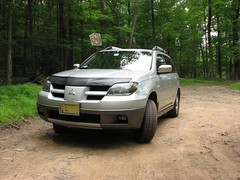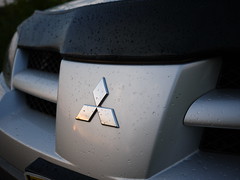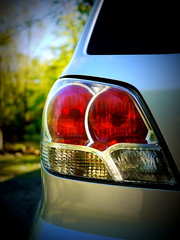 To keep this “Behind the Wheel” series going I thought I’d mix things up a bit and give some thoughts on cars I’ve actually owned, as opposed to ones I’ve just driven for short periods of time.
To keep this “Behind the Wheel” series going I thought I’d mix things up a bit and give some thoughts on cars I’ve actually owned, as opposed to ones I’ve just driven for short periods of time.
We’ll begin this little mini-series with my current car, a 2003 Mitsubishi Outlander XLS AWD (which I affectionately call “The Keithmobile-D”).
To start with, the Mitsubishi Outlander is… a kind of a weird little car/SUV/thing – and I’m not just talking about its odd front nose & hood bulge. The Outlander is a strange mix of stylish “tall station wagon” city SUV and hard-working and reasonably capable “utility vehicle.”
 Then again, I suppose this shouldn’t be a surprise, since Mitsubishi itself is kind of an oddball car company, with precious few models compared to some of the bigger car companies – especially here in the US, and especially nowadays when they basically only have 3 models – the Lancer, the Outlander, and the Mirage. But Mitsubishi has always had to live under the shadow of the bigger companies – Toyota, Honda, Mazda, and especially Subaru.
Then again, I suppose this shouldn’t be a surprise, since Mitsubishi itself is kind of an oddball car company, with precious few models compared to some of the bigger car companies – especially here in the US, and especially nowadays when they basically only have 3 models – the Lancer, the Outlander, and the Mirage. But Mitsubishi has always had to live under the shadow of the bigger companies – Toyota, Honda, Mazda, and especially Subaru.
But let’s rewind back to 2003: Mitsubishi has always had a kind of competition with Subaru, what with the whole EVO vs. WRX thing. For a while there this almost seemed like it would carry over into other models, too – with the Outlander poised to compete with the Subaru Outback (right down to the similar-sounding name). Though in my opinion, the Outlander seemed more like the Forrester at the time, since it is a bit of a taller wagon/SUV shape than the decidedly station-wagon-shaped Outback.
The Outlander is kind of a weird mashup of parts from Mitsubishi’s stable of previous vehicles – the chassis is derived from that of the Lancer, but the engine is the same as the one from the Eclipse & Galant. Specifically, it chugs along thanks to a 2.4L 4-cylinder Mitsubishi “Sirius” 4G64 direct-injection engine, which produces a somewhat underwhelming 140 HP (at 5,000 RPM) but a respectable 157 lbs-ft of torque at just 2,500 RPM. That said, the Outlander weighs just a hair under 3,500 lbs, which is a bit hefty for a car of its size, and which means it’s certainly not the fastest thing on the road – but it’s not the slowest thing, either.
It does have 4-wheel independent suspension, and it handles the bumps quite well – much better, in fact, than some more modern cars. Driving on some old cobblestone streets in New York City can be downright painful in modern cars with their stiff suspensions, but the Outlander just soaks up the bumps without much fuss or bother.
 Despite the somewhat soft suspension, it does handle quite well with relatively little body roll (thanks to ample anti-roll and anti-sway bars). Although the steering suffers from the usual horrible Mitsubishi turning radius, it is well balanced with plenty of feedback – there’s no problem at all just diving right into some tight corners. In fact, the Outlander is really quite fun in the corners, despite technically being an SUV. It also helps that it’s not a terribly tall vehicle, either.
Despite the somewhat soft suspension, it does handle quite well with relatively little body roll (thanks to ample anti-roll and anti-sway bars). Although the steering suffers from the usual horrible Mitsubishi turning radius, it is well balanced with plenty of feedback – there’s no problem at all just diving right into some tight corners. In fact, the Outlander is really quite fun in the corners, despite technically being an SUV. It also helps that it’s not a terribly tall vehicle, either.
Despite only having a 4-speed automatic transmission (manuals were made, but not available in the US until later model years) it does have a semi-manual mode so you can (kind of) row through the gears on your own.
One downside to the Outlander is its brakes – they are rather lame, especially by modern standards. At the time, anti-lock brakes were an option, and the 2003 models were only available with front discs and rear drums – it wasn’t until the slightly revised 2004 model that they got 4-wheel disc brakes.
With 8.3 inches of ground clearance the Outlander does reasonably well off-road (compared to other car-based SUVs), although it really is more of a “soft-roader” than an “off-roader.” Plus, though it has AWD (full-time via a center viscous coupling unit with a 50/50 front/rear split) the front & rear differentials themselves are fully open, so it isn’t meant for true hardcore off-roading.
One thing the Outlander does have going for it is utility – it is a very useful car. Unlike some other small SUVs it seats a full 5 people without any trouble and yet still has plenty of room in the back for stuff. Fold down the seats and the Outlander can carry an impressive amount of stuff. Also unlike a lot of modern small car-based SUVs, the Outlander can still tow – although not very much, thanks to its lackluster brakes.
It also has one of the best instrument clusters I’ve seen in recent years – easy to read in both full sun and at night, regardless of whether you have the headlights (and thus, the backlights for the gauges) turned on or not.
All in all the Outlander is a well-designed, well-thought-out little SUV, which I think could have done quite well. Sadly, however, very few people bought the Outlander, and in subsequent years Mitsubishi enlarged it, making it into a bigger, heavier, more expensive people-mover SUV. (The current model Outlanders come with 3 rows of seats, for example, along with lower ground clearance, and a price nearly twice what they were originally.) Mitsubishi used to have a larger SUV, called the “Endeavor,” which fit in the next segment above the Outlander, but it looks like that’s been removed and the Outlander was pushed up into its spot – leaving no small SUV to take its place.
If Mitsubishi had stuck with the same body size, and added a stick shift & a turbocharged engine as an option (both of which were available in other markets worldwide, just not in the US), I think the Outlander would’ve been a hit. But since they didn’t, we’re left with just a few examples of what could have been.
Still, if you’re in the market for a small, fun, useful SUV and don’t want to pay a lot, a used Outlander from 2003-2006 might be worth looking at. If it’s in good shape and has been taken care of, an Outlander is a great alternative to one of its Subaru contemporaries – and probably at a lower price. I know I’m biased, but I’ve been very happy with my Outlander – I bought mine new in 2003, and as of this writing it just ticked over 190,000 miles with no sign of slowing down.
Here’s to that SUV with the funny looking nose from Mitsubishi!
